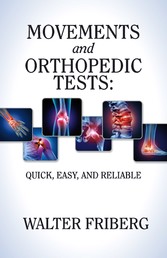Suche
Lesesoftware
Info / Kontakt

Movements and Orthopedic Tests: quick, easy, and reliable
von: Walter Friberg
BookBaby, 2020
ISBN: 9781098338206 , 100 Seiten
Format: ePUB
Kopierschutz: DRM




Preis: 11,89 EUR
eBook anfordern 
CERVICAL and THORACIC SPINE TESTS
Tests for topical diagnosis of the cervical and thoracic spine
Movements testing
The movement tests design to evaluate the involvement in the pathological process particular muscles, nerves and nerve roots. The examiner should not only to conduct the tests but also observe how the patient executes the particular movements. These tests can help localize a lesion to the particular cortical or white matter region, spinal cord level, nerve root, peripheral nerve, or muscle. Movement tests quantify by using muscle strength (MS). All tests and movements testing in particular depend on the patient’s cooperation and sufficient efforts. If the patient consciously or unconsciously unable to cooperate, the examiner should document “insufficient efforts” and try to observe and appreciate MS indirectly. For example, observe the patient’s ability to put on/ takes off clothes, lace shoes, fasten buttons and zips and write/ type on a computer during fill out the office papers. The examiner may quickly test of the upper extremity movements analyzing muscle strength of the certain muscles. Testing of the strength of each muscle group should be performed in a consistent uniform order. The examiner should test symmetrical muscles started with the dominant extremity. MS is rated on a scale of 0/5 to 5/5:
- 0/5: no contraction.
- 1/5: muscle flicker, but no movements.
- 2/5: movement possible, but not against gravity (test the joint in its horizontal plane).
- 3/5: movement possible against gravity, but not against resistance by the examiner.
- 4/5: movement possible against some resistance by the examiner. This is the most common category. This category is divided into three subcategories: 4–/5, 4/5, and 4+/5. However, this is a very subjective.
- 5/5: normal strength.
Quick topical diagnosis of the cervicothoracic spinal segments and muscles
| Movements | Cervicothoracic | Major muscles |
| Elbow Flexion | C5 | Biceps, Brachialis |
| Wrist Extension | C6 | Extensor Carpi Radialis Longus and Brevis |
| Elbow Extension | C7 | Triceps |
| Middle Finger Flexion | C8 | Flexor Digitorum Profundus to the middle finger |
| Small Finger Abduction | T1 | Flexor Digitorum Profundus |
Movement tests of upper extremities
| Action | Muscles | Nerves | Cervicothoracic |
| Finger Extension | Extensor Digitorum, Extensor Indicis, Extensor Digiti Minimi | Radial nerve (posterior interosseous nerve) | C7, C8 |
| Thumb ABDuction* in plane of palm | Abductor Pollicis Longus | Radial nerve (posterior interosseous nerve) | C7, C8 |
| Finger ABDuction* | Dorsal Interossei, Abductor Digiti Minimi | Ulnar nerve | C8, T1 |
| Finger and thumb ADDuction* in plane of palm | Adductor Pollicis, Palmar Interossei | Ulnar nerve | C8, T1 |
| Thumb Opposition | Opponens Pollicis | Median nerve | C8, T1 |
| Thumb ABDuction* perpendicular to plane of palm | Abductor Pollicis Brevis | Median nerve | C8, T1 |
| Flexion at distal interphalangeal joints digits 2, 3 | Flexor Digitorum Profundus to digits 2, 3 | Median nerve | C7, C8 |
| Flexion at distal interphalangeal joints digits 4, 5 | Flexor Digitorum Profundus to digits 4, 5 | Ulnar nerve | C7, C8 |
| Wrist Flexion and hand ABDuction* | Flexor Carpi Radialis | Median nerve | C6, C7 |
| Wrist Flexion and hand ADDuction* | Flexor Carpi Ulnaris | Ulnar nerve | C7, C8, T1 |
| Wrist Extension and hand ABDuction* | Extensor Carpi Radialis | Radial nerve | C5, C6 |
| Elbow Flexion (with forearm supinated) | Biceps, Brachialis | Musculocutaneous nerve | C5, C6 |
| Elbow Extension | Triceps | Radial nerve | C6, C7, C8 |
| Arm ABDuction* at shoulder | Supraspinatus initiates abduction of the arm from 0 to 15°. Beyond 15° the Deltoid becomes more effective at abducting the arm and becomes the main propagator of the ABDuction | Axillary nerve | C5, C6 |
*I capitalized first three letters in words Abduction and Adduction to distinguish the opposite movements.
Bakody Sign
Indications: suggestive for the cervical radiculopathy at the levels of C4-C6. Test is indicative for the nerve root irritation due to cervical foraminal compression.
Patient’s position: sitting upright.
Technique: Either the patient actively, or the examiner passively, place the patient’s hand on top of his/her head.
Interpretation: the test is positive if the patient reports decrease pain.
Clinical Notes: Reverse Bakody Sign can be noted when the patient resists raising the arm and hand toward the head. This finding should be correlated with other orthopedic testing, as it could indicate facet irritation, glenohumeral dysfunction, rotator-cuff trauma or myofascial spasm.
Doorbell Sign (Anterior Cervical Doorbell Push...




